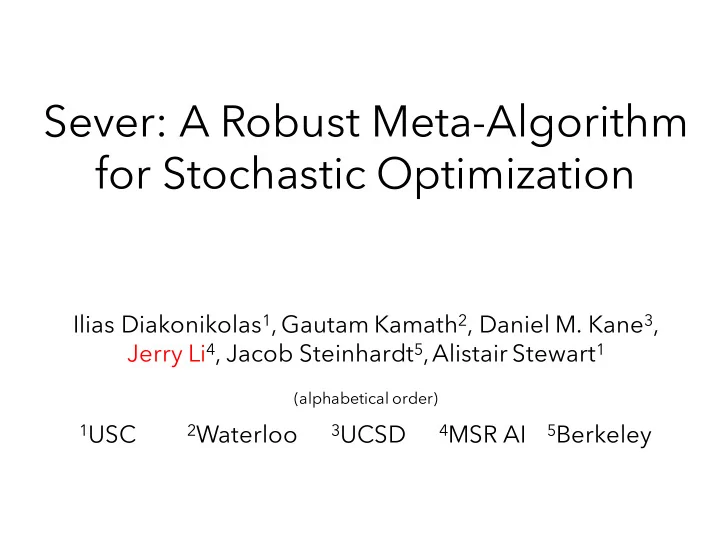

Sever: A Robust Meta-Algorithm for Stochastic Optimization Ilias Diakonikolas 1 , Gautam Kamath 2 , Daniel M. Kane 3 , Jerry Li 4 , Jacob Steinhardt 5 , Alistair Stewart 1 (alphabetical order) 1 USC 2 Waterloo 3 UCSD 4 MSR AI 5 Berkeley
DEFENDING AGAINST DATA POISONING Main question: can you learn a good classifier from poisoned training data?
DEFENDING AGAINST DATA POISONING Main question: can you learn a good classifier from poisoned training data? Given a labeled training set, where an (unknown) 𝜁 -fraction of them are adversarially corrupted, can we learn a model which achieves good accuracy on a clean test set?
DEFENDING AGAINST DATA POISONING Main question: can you learn a good classifier from poisoned training data? Example: Training an SVM with 3% poisoned data
DEFENDING AGAINST DATA POISONING Main question: can you learn a good classifier from poisoned training data? Example: Training an SVM with 3% poisoned data [Koh-Steinhardt-Liang ’18] Against known defenses, the test error can go up to 30%!
DEFENDING AGAINST DATA POISONING Main question: can you learn a good classifier from poisoned training data? Example: Training an SVM with 3% poisoned data Lots of work on related problems: [Barreno-Nelson-Joseph-Tygar’10,Nasrabadi-Tran-Nguyen’11, Biggio-Nelson-Laskov’12, Nguyen-Tran’13, Newell-Potharaju- Xiang-Nita-Rotaru’14, Bhatia-Jain-Kar’15, Diakonikolas- Kamath-Kane-L-Moitra-Stewart’16, Bhatia-Jain-Kamalaruban- Kar’17, Balakrishnan-Du-L-Singh’17, Charikar-Steinhardt- Valiant’17, Steinhardt-Koh-Liang’17, Koh-Liang’17, Prasad- Suggala-Balakrishnan-Ravikumar’18, Diakonikolas-Kong- Stewart’18, Klivans-Kothari-Meka’18,Koh-Steinhardt- [Koh-Steinhardt-Liang ’18] Liang’18…] Against known defenses, the test error can go up to 30%!
OUR RESULTS We present a framework for robust stochastic optimization • Strong theoretical guarantees against strong adversarial models • Outperforms benchmark defenses on state-of-the-art data poisoning attacks • Works well in high dimensions • Works with black-box access to any learner for any stochastic optimization task
SEVER Idea: Until termination: 1. train black box learner to find approximate minima of empirical risk on corrupted training set, 2. then run outlier detection method on the gradients of the loss functions at ERM to remove suspected outliers
SEVER Idea: Until termination: 1. train black box learner to find approximate minima of empirical risk on corrupted training set, 2. then run outlier detection method on the gradients of the loss functions at ERM to remove suspected outliers Filter
FILTERING AND ROBUST MEAN ESTIMATION How should we detect outliers from the gradients?
FILTERING AND ROBUST MEAN ESTIMATION How should we detect outliers from the gradients? We exploit a novel connection to robust mean estimation
FILTERING AND ROBUST MEAN ESTIMATION How should we detect outliers from the gradients? We exploit a novel connection to robust mean estimation Filtering [DKKLMS16, DKKLMS17]: Given a set of points 𝑌 # , … , 𝑌 & drawn from a “nice” distribution, but where an 𝜁 -fraction are corrupted, there is a linear time algorithm which either:
FILTERING AND ROBUST MEAN ESTIMATION How should we detect outliers from the gradients? We exploit a novel connection to robust mean estimation Filtering [DKKLMS16, DKKLMS17]: Given a set of points 𝑌 # , … , 𝑌 & drawn from a “nice” distribution, but where an 𝜁 -fraction are corrupted, there is a linear time algorithm which either: 1. Certifies that the true mean is close to the empirical mean of the corrupted dataset
FILTERING AND ROBUST MEAN ESTIMATION How should we detect outliers from the gradients? We exploit a novel connection to robust mean estimation Filtering [DKKLMS16, DKKLMS17]: Given a set of points 𝑌 # , … , 𝑌 & drawn from a “nice” distribution, but where an 𝜁 -fraction are corrupted, there is a linear time algorithm which either: 1. Certifies that the true mean is close to the empirical mean of the corrupted dataset 2. Removes more bad points than good points
FILTERING AND ROBUST MEAN ESTIMATION How should we detect outliers from the gradients? We exploit a novel connection to robust mean estimation Filtering [DKKLMS16, DKKLMS17]: Given a set of points 𝑌 # , … , 𝑌 & drawn from a “nice” distribution, but where an 𝜁 -fraction are corrupted, there is a linear time algorithm which either: 1. Certifies that the true gradient of the loss function is close to 0 2. Removes more bad points than good points
GUARANTEES Theorem (informal) : Suppose we have a distribution ≼ 𝜏 1 𝐽 . Suppose over convex functions 𝑔 , and Cov 𝛼𝑔 𝜄 we have 𝑔 & (𝜄) drawn from , where 𝜁 -fraction # (𝜄), 𝑔 1 (𝜄), … , 𝑔 of them are adversarial. Under mild assumptions on , then 5 so that w.h.p. given enough samples, SEVER outputs a 𝜄 5) − min 𝜏 1 𝜁 . 𝑔̅(𝜄 ; 𝑔 𝜄 < 𝑃 Can also give results for non-convex objectives Sample complexity / runtime are polynomial but not super tight For GLMs (e.g. SVM, regression), we obtain tight(er) bounds
EMPIRICAL EVALUATION: REGRESSION
EMPIRICAL EVALUATION: SVM
CONCLUSIONS Main question: can you learn a good classifier from poisoned data? Sever is a meta-algorithm for robust stochastic optimization Filter Based on connections to robust mean estimation Interested? See poster #143 this evening!
Recommend
More recommend